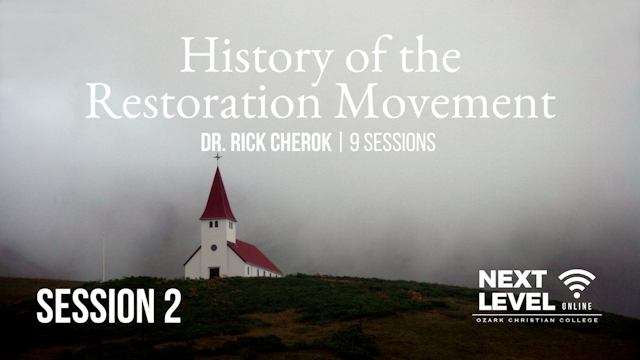Barton W. Stone and the Last Will and Testament


The vision of Ozark Christian College is to glorify God by evangelizing the lost and edifying Christians worldwide. The mission of Ozark Christian College is to train men and women for Christian service as a degree-granting institution of biblical higher education.
1772 – Born near Port Tobacco, Maryland on December 24th.
1793 – Graduated from the Caldwell Academy in North Carolina.
1796 – Became the minister of the Cane Ridge and Concord Churches, where he remained until 1812.
1798 – Ordination: When asked if he accepted the Westminster Confession of Faith, Stone replied, “I do, so far as I see it consistent with the Word of God.”
1801 – Great Revival hosted by B.W. Stone and the Cane Ridge Church. Stone addressed the crowds from a tree stump. 1. Estimates of between 10,000-30,000 people attended the Cane Ridge Revival.
1803 – The Presbyterian Synod of Kentucky accused Stone and the other revivalists of heresy because of the revival. Stone and a few others broke from the synod to form the Springfield Presbytery.
June 28, 1804 – Stone and the other revivalists disband the Springfield Presbytery at the Cane Ridge Meeting House by issuing the “Last Will and Testament of the Springfield Presbytery”. Many consider this the beginning of the Restoration Movement.
1807 – Stone and most members of the Cane Ridge congregation accepted immersion as the New Testament form of baptism and were immersed.
1824– Stone met Alexander Campbell for the first time while Campbell was traveling through Kentucky.
1826 – Began publication of the Christian Messenger, a periodical Stone would publish for the remainder of his life.
1831-1832 – The followers of Stone and Campbell were united by meetings held over Christmas and New Years in central Kentucky.
1841 – Stone suffered a debilitating stroke.
November 9, 1844 – Stone died at the home of his daughter in Hannibal, Missouri.
1847 – Stone’s body was removed to its current resting place in the cemetery at the Cane Ridge Meeting House in Kentucky.
Upon the occasion of Stone’s death, Alexander Campbell referred to Stone as “the honored instrument of bringing many out of the ranks of human tradition and putting into their hands the Book of Books as their only confession of faith and rule of life”.
Additional Resources:
Boles, John B. – The Great Revival: Beginnings of the Bible Belt
Conkin, Paul K. – Cane Ridge: America’s Pentecost
Dickinson, Hoke S., ed. – The Cane Ridge Reader
Dunnavant, Anthony, ed. – Cane Ridge in Context: Perspectives on Barton W. Stone and the Revival
Williams, D. Newell – Barton Stone: A Spiritual Biography
Websites:
Cane Ridge Meeting House – www.caneridge.org
Last Will and Testament of the Springfield Presbytery –
https://en.wikisource.org/wiki/Last_Will_and_Testament_of_The_Springfield_Pr esbytery
1772 – Born near Port Tobacco, Maryland on December 24th.
1793 – Graduated from the Caldwell Academy in North Carolina.
1796 – Became the minister of the Cane Ridge and Concord Churches, where he remained until 1812.
1798 – Ordination: When asked if he accepted the Westminster Confession of Faith, Stone replied, “I do, so far as I see it consistent with the Word of God.”
1801 – Great Revival hosted by B.W. Stone and the Cane Ridge Church. Stone addressed the crowds from a tree stump. 1. Estimates of between 10,000-30,000 people attended the Cane Ridge Revival.
1803 – The Presbyterian Synod of Kentucky accused Stone and the other revivalists of heresy because of the revival. Stone and a few others broke from the synod to form the Springfield Presbytery.
June 28, 1804 – Stone and the other revivalists disband the Springfield Presbytery at the Cane Ridge Meeting House by issuing the “Last Will and Testament of the Springfield Presbytery”. Many consider this the beginning of the Restoration Movement.
1807 – Stone and most members of the Cane Ridge congregation accepted immersion as the New Testament form of baptism and were immersed.
1824– Stone met Alexander Campbell for the first time while Campbell was traveling through Kentucky.
1826 – Began publication of the Christian Messenger, a periodical Stone would publish for the remainder of his life.
1831-1832 – The followers of Stone and Campbell were united by meetings held over Christmas and New Years in central Kentucky.
1841 – Stone suffered a debilitating stroke.
November 9, 1844 – Stone died at the home of his daughter in Hannibal, Missouri.
1847 – Stone’s body was removed to its current resting place in the cemetery at the Cane Ridge Meeting House in Kentucky.
Upon the occasion of Stone’s death, Alexander Campbell referred to Stone as “the honored instrument of bringing many out of the ranks of human tradition and putting into their hands the Book of Books as their only confession of faith and rule of life”.
Additional Resources:
Boles, John B. – The Great Revival: Beginnings of the Bible Belt
Conkin, Paul K. – Cane Ridge: America’s Pentecost
Dickinson, Hoke S., ed. – The Cane Ridge Reader
Dunnavant, Anthony, ed. – Cane Ridge in Context: Perspectives on Barton W. Stone and the Revival
Williams, D. Newell – Barton Stone: A Spiritual Biography
Websites:
Cane Ridge Meeting House – www.caneridge.org
Last Will and Testament of the Springfield Presbytery –
https://en.wikisource.org/wiki/Last_Will_and_Testament_of_The_Springfield_Pr esbytery
© Live Church Solutions. All rights reserved.
